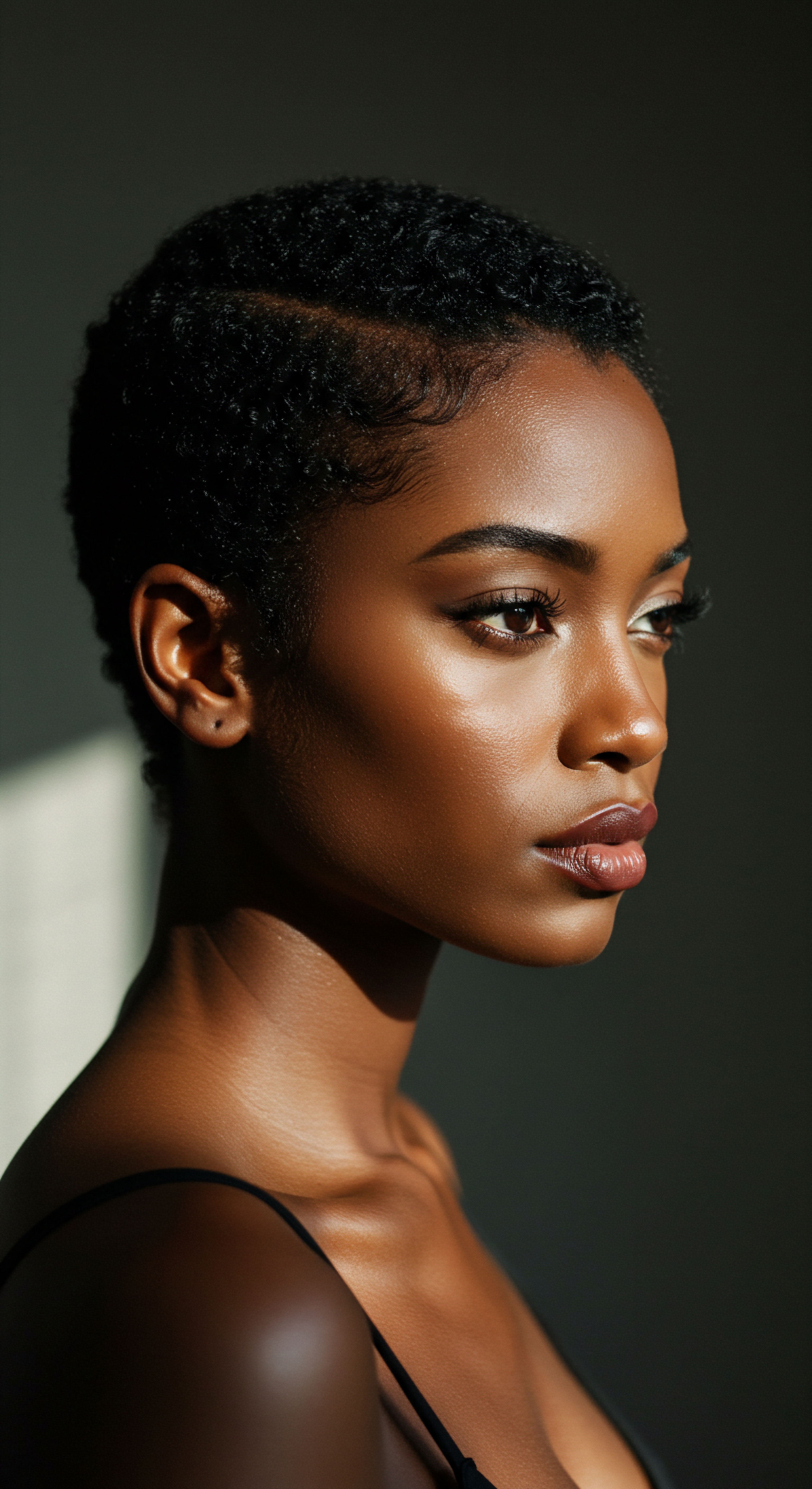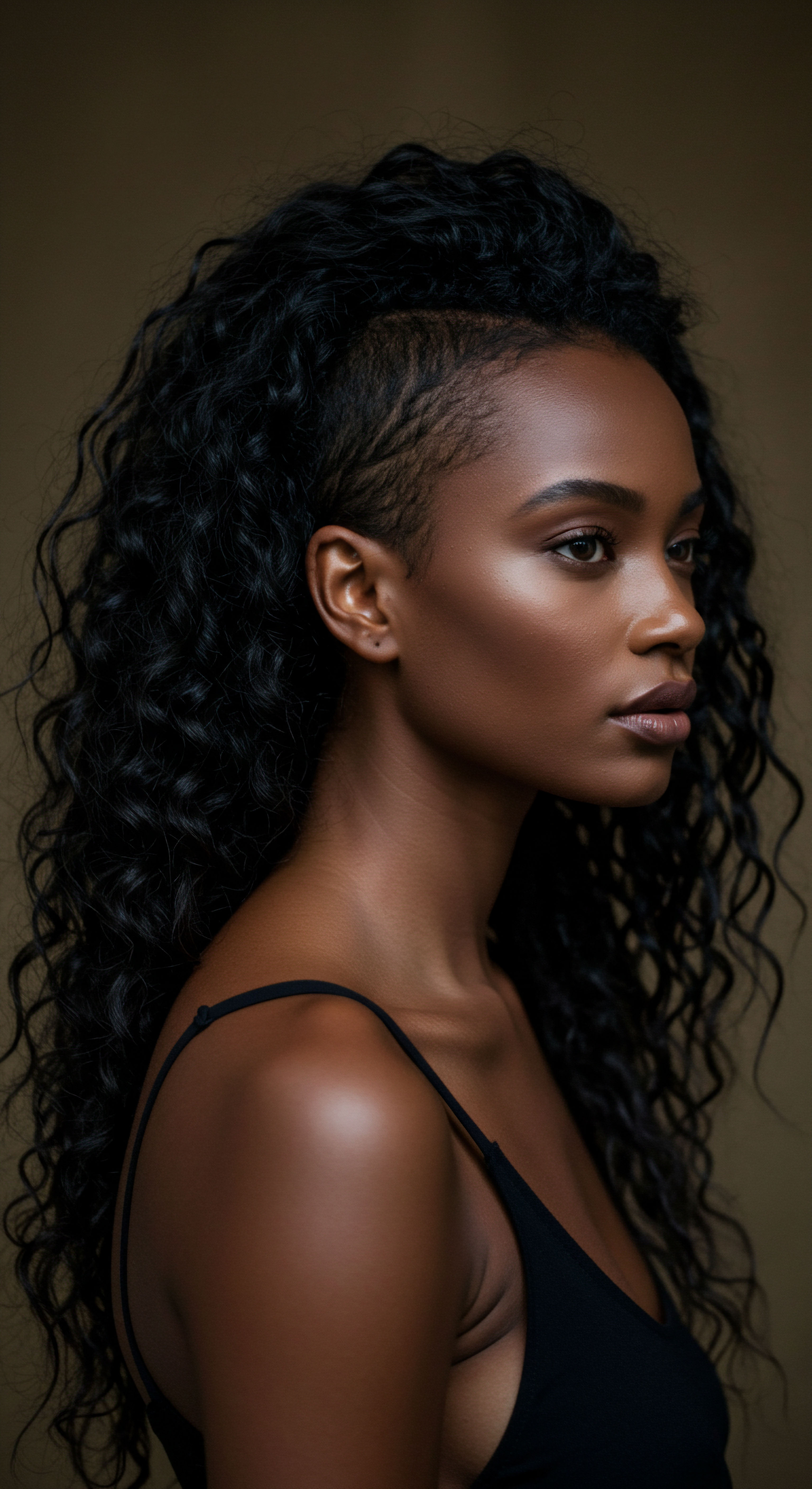
Roots
To truly understand how ancient civilizations approached the care of their strands, one must first sense the whisper of the wind across sun-baked lands or the damp embrace of a humid breeze. Our modern routines, filled with myriad products, often obscure the profound connection between early human communities and their immediate surroundings. Hair, far from being a mere adornment, served as a living shield, a cultural marker, and a canvas reflecting environmental realities.
The story of ancient hair moisturizing practices is not simply a chronicle of ingredients; it is a testament to human ingenuity, a careful dance with nature’s offerings, sculpted by the very air, sun, and moisture of a given landscape. This exploration invites us to consider the elemental forces that shaped how our ancestors kept their hair vibrant and protected, offering a glimpse into a time when every drop of oil, every plant extract, was a direct response to the world outside their dwelling.

What is the Fundamental Role of Climate in Hair Health?
The interaction between hair and its environment is a fundamental biological principle. Hair, composed primarily of keratin, possesses a remarkable capacity to absorb and release moisture, a process directly influenced by ambient humidity and temperature. In arid climates, the air’s low moisture content draws hydration from hair, leading to dryness, brittleness, and increased susceptibility to breakage. Conversely, high humidity can cause the hair shaft to swell, disrupting its cuticle and leading to frizz, particularly for textured hair types.
Temperature also plays a significant role; intense sun exposure can degrade hair proteins and pigments, while cold, dry air can strip natural oils, leaving strands parched. The very structure of hair, whether straight, wavy, or tightly coiled, also influences its response to these environmental factors. For instance, tightly coiled hair, common in populations from high-sunlight regions, offers greater protection against solar radiation due to its dense configuration, yet its helical structure also presents more points of vulnerability for moisture escape, making it more prone to dryness.
Understanding this intrinsic relationship reveals why ancient peoples, living in intimate synchronicity with their environments, developed specific practices. Their solutions were not random but rather precise adaptations, honed over generations, to mitigate the specific challenges posed by their local climate. From the scorching deserts of Egypt to the lush riverbanks of India, the plant life, animal resources, and even the very rhythm of daily life were dictated by climatic conditions, directly informing the substances chosen for hair care.
Ancient hair moisturizing practices were not random beauty choices but rather ingenious adaptations to local environmental challenges.

How Did Hair Respond to Arid Climates?
In regions characterized by intense heat and minimal rainfall, such as ancient Egypt or parts of the Middle East, the primary climatic assault on hair was dehydration. The relentless sun and dry winds constantly stripped strands of their natural moisture, leaving them vulnerable to damage. To counteract this, ancient Egyptians, for example, turned to a rich array of plant-based oils and animal fats.
Evidence from archaeological findings and ancient texts suggests a widespread use of substances like Castor Oil, Moringa Oil, and Sesame Oil. These oils, often extracted from locally abundant flora, served as occlusive agents, forming a protective barrier on the hair shaft to seal in moisture and shield against environmental aggressors.
Beyond plant oils, animal fats were also integral. Analysis of mummified hair samples from ancient Egypt has revealed the presence of fatty substances, identified as biological long-chain fatty acids, likely derived from animal fats. These substances were not only used for styling but also for conditioning, helping hair retain its suppleness in the unforgiving desert air. The use of wigs, prevalent among the elite, also served a practical purpose in this climate, offering protection to the scalp from the sun’s harsh rays and providing a cleaner, more comfortable alternative to natural hair that might struggle with dryness and lice infestations in such conditions.

How Did Hair Respond to Humid Climates?
In stark contrast to arid zones, humid climates presented a different set of challenges. Regions like ancient India or parts of East Asia, characterized by high atmospheric moisture, meant hair was constantly exposed to water vapor. While some moisture is beneficial, excessive humidity causes the hair cuticle to lift, leading to swelling, tangling, and the phenomenon commonly known as frizz. For populations with naturally textured or curly hair, this effect is often more pronounced.
Ancient Indian Ayurvedic practices offer a profound example of adapting to humidity. Ayurvedic texts, dating back thousands of years, document the use of ingredients like Coconut Oil, Neem Oil, and various herbal blends. Coconut oil, with its unique molecular structure, is known to penetrate the hair shaft, reducing protein loss and helping to smooth the cuticle, thus mitigating the effects of humidity. Neem oil, prized for its antifungal and antibacterial properties, addressed scalp health concerns that could arise in moist environments.
The practice of regular oiling, often followed by gentle cleansing with natural ingredients like shikakai or amla, aimed to maintain a balanced moisture level, preventing both excessive absorption and subsequent dryness. This approach recognized that moisture balance was paramount, not just adding moisture, but managing how hair interacted with the abundant atmospheric water.

Ritual
Stepping from the elemental understanding of climate’s touch on hair, we now turn to the deliberate actions, the rhythms of care that ancient hands performed. These were not merely acts of grooming; they were rituals, deeply ingrained in daily life and cultural identity, each stroke and application carrying layers of meaning. The way ancient peoples moisturized their hair was a direct, embodied conversation with their environment, a testament to practical wisdom passed through generations. We consider the methods, the cherished ingredients, and the cultural frameworks that gave shape to these practices, moving beyond simple application to reveal the thoughtful intent behind every ritual.

What Daily Moisturizing Rituals Did Ancient Cultures Practice?
The daily and periodic moisturizing practices of ancient civilizations were intricately linked to their local climates and available resources. These were not isolated acts but often part of broader hygiene and beautification routines.
- Egyptian Oiling ❉ In ancient Egypt, regular application of oils was a common practice for both men and women. This was a direct response to the dry, desert climate. Oils like Castor, Almond, and Moringa were massaged into the hair and scalp. These applications helped to protect the hair from the harsh sun and wind, providing a layer of hydration and sheen. Beyond simple moisture, these oils also acted as styling agents, with archaeological findings suggesting the use of fat-based gels to hold elaborate hairstyles.
- Indian Ayurvedic Oil Massage ❉ The practice of ‘Champi’ or hair oiling in ancient India, rooted in Ayurveda, was a deeply spiritual and practical ritual. Coconut and sesame oils were commonly used, often warmed and infused with herbs like amla, neem, and hibiscus. This practice was not merely about moisturizing; it aimed to balance the body’s doshas, stimulate blood circulation in the scalp, and prevent various hair and scalp ailments that could be exacerbated by the humid climate. The choice of oil even adapted to seasons, with sesame oil favored in winter for its warming properties and coconut oil in summer for its cooling effect.
- Mediterranean Olive Oil Application ❉ In ancient Greece and Rome, where the climate was Mediterranean with hot, dry summers and mild, wet winters, Olive Oil was a cornerstone of hair care. Rich in antioxidants and vitamin E, it was massaged into hair to provide hydration, reduce frizz, and impart a healthy luster. Often infused with aromatic herbs like rosemary and lavender, these applications also served a perfuming function, contributing to overall personal hygiene and aesthetic.

How Did Ancient Peoples Source Hair Moisturizing Ingredients?
The sourcing of ingredients for ancient hair moisturizing practices was a direct reflection of the immediate natural environment and the ingenuity of local populations. The concept of ethnobotany, the study of how people use plants, reveals the profound connection between ancient communities and their botanical surroundings.
In regions with abundant olive groves, such as the Mediterranean basin, olive oil became a staple not only for culinary purposes but also for skin and hair care. Its ready availability and inherent moisturizing properties made it a logical choice. Similarly, in ancient India, the widespread cultivation of coconut palms meant coconut oil was a readily accessible and highly valued commodity for hair treatments.
Beyond common agricultural products, specialized knowledge of local flora led to the discovery and utilization of more unique ingredients. For example, in parts of ancient Africa, indigenous communities utilized shea butter, extracted from the nuts of the shea tree, for its rich emollient properties, particularly beneficial in dry, hot climates. The Himba tribe of Namibia, even today, coats their hair with a mixture of butterfat and red ochre, a practice that offers protection against the harsh desert sun and dryness. This deep, traditional knowledge of plant and animal resources, passed down through generations, allowed ancient peoples to create sophisticated moisturizing compounds directly from their environment.
The selection of ancient hair moisturizing ingredients was a direct ecological dialogue, prioritizing what the local land offered in response to its climatic demands.
| Ingredient Castor Oil |
| Primary Source/Region Ancient Egypt, India |
| Climatic Adaptation Arid climates, provides heavy moisture barrier, promotes growth. |
| Ingredient Olive Oil |
| Primary Source/Region Ancient Greece, Rome, Mediterranean |
| Climatic Adaptation Mediterranean climate, offers hydration, reduces frizz, provides shine. |
| Ingredient Coconut Oil |
| Primary Source/Region Ancient India, Southeast Asia |
| Climatic Adaptation Humid climates, penetrates hair shaft, reduces protein loss, manages frizz. |
| Ingredient Moringa Oil |
| Primary Source/Region Ancient Egypt |
| Climatic Adaptation Arid climates, lightweight yet nourishing, protects from sun. |
| Ingredient Shea Butter |
| Primary Source/Region Parts of Ancient Africa |
| Climatic Adaptation Dry, hot climates, rich emollient, provides intense moisture. |
| Ingredient Animal Fats (e.g. Lard, Tallow) |
| Primary Source/Region Ancient Egypt, Europe |
| Climatic Adaptation Varies, used for styling, conditioning, and protection in various climates. |
| Ingredient Honey |
| Primary Source/Region Middle East, Egypt, Greece |
| Climatic Adaptation Humectant, attracts and retains moisture in varying climates. |

Relay
Having journeyed through the foundational influences of climate and the deliberate practices born from them, we now consider the deeper currents that carried these traditions through time and across cultures. This section explores the intricate interplay of science, social structures, and shared human needs that allowed ancient hair moisturizing practices to persist, adapt, and inform our understanding of hair health today. It is a relay of knowledge, passed from one generation to the next, often silently, through observation and direct teaching, shaping not only physical appearance but also cultural identity.

What Scientific Principles Underpinned Ancient Moisturizing Methods?
While ancient civilizations lacked modern scientific terminology, their hair moisturizing practices were, at their core, rooted in empirical observation of material properties and biological responses. They intuitively grasped principles that modern science now elucidates.
Consider the use of oils and fats. These substances are lipids, forming a hydrophobic layer that repels water, thereby minimizing moisture loss from the hair shaft in dry conditions. In hot, arid environments, this occlusive barrier was essential to prevent desiccation. The specific fatty acid profiles of different oils also contributed to their efficacy.
For instance, coconut oil, rich in lauric acid, possesses a molecular structure that allows it to penetrate the hair cuticle, offering internal conditioning and reducing protein loss, a benefit particularly relevant in humid climates where hair swelling and cuticle damage are common. Olive oil, with its oleic acid content, provides a surface coating that smooths the cuticle, reducing friction and enhancing shine.
The inclusion of humectants, such as honey, in some ancient formulations also points to an understanding of moisture attraction. Honey, a natural humectant, draws water from the atmosphere, helping to keep hair hydrated even in fluctuating humidity. Moreover, the practice of scalp massage, integral to many ancient rituals, was not merely for relaxation.
It stimulated blood circulation to the hair follicles, enhancing nutrient delivery and promoting overall scalp health, which directly impacts the quality and moisture retention of new hair growth. These ancient methods, therefore, were not just aesthetic choices; they were pragmatic applications of observed natural chemistry and biology.
Ancient hair care practices, though lacking modern scientific language, intuitively applied principles of lipid chemistry and humectancy to protect and hydrate hair.

How Did Cultural Beliefs Shape Hair Care Adaptations?
Beyond the immediate practicalities of climate, cultural beliefs, social status, and spiritual significance profoundly influenced ancient hair moisturizing practices. Hair was rarely just hair; it was a powerful symbol, and its care was intertwined with identity.
In ancient Egypt, for example, hair and wigs were indicators of social standing and cleanliness. Priests often shaved their heads for ritual purity, while the elite wore elaborate wigs, sometimes made of human hair and plant fibers, which were themselves treated with fats and resins to maintain their structure and luster in the dry climate. The care of these wigs, including their regular oiling, became an extension of personal and social presentation. This reflects a cultural adaptation where even when natural hair was removed for comfort or hygiene in the arid conditions, the appearance of healthy, well-moisturized hair was maintained through artificial means, signaling status and adherence to beauty ideals.
In contrast, within many African cultures, hair was a medium for storytelling, a reflection of age, marital status, or tribal affiliation. Intricate braiding and coiling styles, often treated with natural butters and oils like shea butter or plant-infused animal fats (as seen with the Basara tribe’s Chebe mixture), provided both protective styling and deep conditioning. These practices were not just about combating dryness; they were acts of cultural continuity, community bonding, and self-expression, where the physical act of moisturizing was imbued with social and spiritual meaning. The choice of styling and moisturizing agents was thus a blend of climatic necessity and deeply held cultural values.
- Climate Adaptation ❉ The direct physical impact of environmental conditions on hair structure and moisture levels necessitated specific ingredient choices.
- Resource Availability ❉ Local flora and fauna dictated the primary substances used for moisturizing.
- Cultural Significance ❉ Hair’s symbolic role in society influenced the methods and rituals of care, often transcending mere physical needs.

What Unconventional Evidence Reveals Ancient Moisturizing Secrets?
While ancient texts and archaeological finds of cosmetic tools offer clear insights, some less conventional avenues of research also shed light on historical hair moisturizing practices. One compelling, though perhaps unsettling, source of information comes from the analysis of bog bodies. These naturally preserved human remains, found in peat bogs, offer unique insights into Iron Age European life, including hair care.
A notable example is the Clonycavan Man, an Iron Age bog body discovered in Ireland, dated to between 392 BCE and 201 BCE. Analysis of his hair revealed the presence of a “hair gel” made from plant oil and pine resin, imported from southwestern France or northern Spain. This finding is particularly striking for several reasons. Firstly, it demonstrates that even in a relatively damp, temperate climate like Iron Age Ireland, hair styling and conditioning with external agents were practiced.
Secondly, the fact that the ingredients were sourced from a distant region speaks to early trade networks and the value placed on specific cosmetic components, even across significant geographical and climatic divides. The resin, a natural polymer, would have provided hold and a protective, moisture-sealing layer, indicating a sophisticated understanding of hair mechanics, even if the primary motivation was aesthetic. This case challenges a simplistic view that moisturizing was solely a response to arid conditions, suggesting a more universal human desire for hair health and styling, adapted with available resources.
This example, while not directly about moisturizing in a hot, dry climate, highlights a crucial point ❉ the human impulse to manipulate and protect hair is ancient and transcends simple survival. The use of a complex, imported resin-based gel in a damp climate suggests a conscious effort to manage hair texture and appearance, even if the primary environmental challenge was not extreme dryness. It underscores that ancient hair care was a blend of practical need, aesthetic desire, and resourcefulness, often involving trade and knowledge exchange across diverse environments.
| Region/Civilization Ancient Egypt |
| Predominant Climate Arid Desert |
| Key Moisturizing Ingredients Castor oil, Moringa oil, Sesame oil, Animal fats, Beeswax, Resins |
| Associated Practices Frequent oiling, wig wearing for protection and status, fat-based styling gels. |
| Region/Civilization Ancient India (Ayurveda) |
| Predominant Climate Tropical/Humid |
| Key Moisturizing Ingredients Coconut oil, Sesame oil, Amla, Neem, Hibiscus, Bhringraj |
| Associated Practices Warm oil scalp massages (Champi), herbal infusions, cleansing with natural powders. |
| Region/Civilization Ancient Greece/Rome |
| Predominant Climate Mediterranean |
| Key Moisturizing Ingredients Olive oil, Honey, Herbal infusions |
| Associated Practices Regular oil application, often perfumed; used for conditioning and shine. |
| Region/Civilization Iron Age Europe (e.g. Ireland) |
| Predominant Climate Temperate/Damp |
| Key Moisturizing Ingredients Plant oil and pine resin (e.g. Clonycavan Man) |
| Associated Practices Styling gels for hold and protection, trade for specific ingredients. |
| Region/Civilization Ancient African Tribes (e.g. Himba, Basara) |
| Predominant Climate Varies (Arid to Savannah) |
| Key Moisturizing Ingredients Shea butter, Animal fats, Red ochre, Chebe powder (herbal mixtures) |
| Associated Practices Protective styling (braids, coils), daily application of butter/oil mixtures for sun/dryness protection. |

Reflection
As we close this exploration into the echoes of ancient hair moisturizing practices, a gentle truth emerges ❉ the relationship between humanity and the natural world is a dance of adaptation, a quiet conversation across millennia. Our ancestors, guided by the sun, the wind, and the gifts of the earth, sculpted their hair care not from fleeting trends but from a deep, abiding respect for their environment. The whispers of these old ways remind us that true hair health is not about battling our strands into submission, but rather about understanding their intrinsic needs, listening to the climate’s influence, and honoring the profound legacy of care that flows from roots deep in history. This journey through time encourages us to consider our own hair not just as a part of our personal style, but as a living testament to an enduring connection with the world around us.

References
- Cherubini, S. (2019). Cosmetics Care Along the Roman Frontier – Archaeological Finds of Ancient Gerulata. In SALVE, EDVARDE! A TOAST TO THE JUBILEE OF PROFESSOR E. KREKOVIČ. J. Mellnerová Šuteková – M. Bača – P. Pavúk (ed).
- McCreesh, N. C. et al. (2011). Ancient Egyptian hair gel ❉ analysis of hair samples from mummies. Journal of Archaeological Science, 38(11), 2950-2954.
- Nath, B. (2010). Herbal cosmetics in ancient India. Pharmacognosy Reviews, 4(8), 170.
- Patel, M. & Sharma, V. (2020). Carrier Oils Benefits and Uses For Natural and Organic Hair Care. International Journal of Current Advanced Research, 9(09), 23297-23301.
- Rastogi, S. (2017). Ayurvedic Hair Care. In Holistic Beauty from the Inside Out. CRC Press.
- Raut, V. & Jain, S. (2019). The Legacy of Lathers ❉ Tracing the Historical Use of Natural Ingredients in Hair Cleansing. Journal of Cosmetic Science, 70(6), 321-330.
- Riddle, J. M. (1992). Dioscorides on Pharmacy and Medicine. University of Texas Press.
- Robins, G. (1993). Women in Ancient Egypt. Harvard University Press.
- Serpico, D. & White, R. (2000). The Use and Identification of Bitumen, Resins and Other Organic Materials in Ancient Egyptian Artefacts. In Egyptian Mummies and Ancient Stories. British Museum Press.
- Shaw, I. & Nicholson, P. (2008). The Oxford Handbook of Ancient Egypt. Oxford University Press.
- Weatherford, J. (2004). Indian Givers ❉ How the Indians of the Americas Transformed the World. Crown.
- Wills, C. & Brier, B. (2005). The History of Mummification. Thames & Hudson.